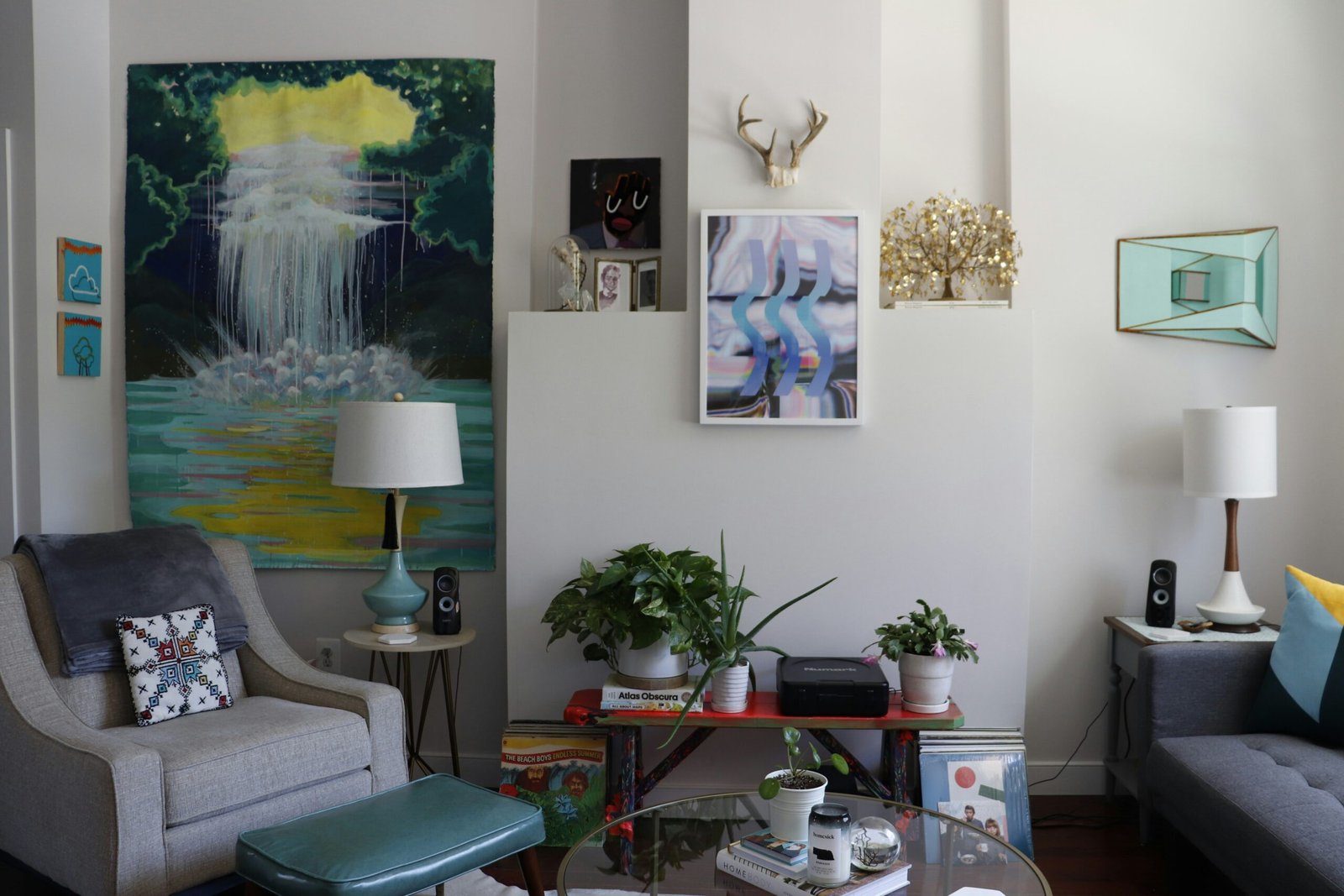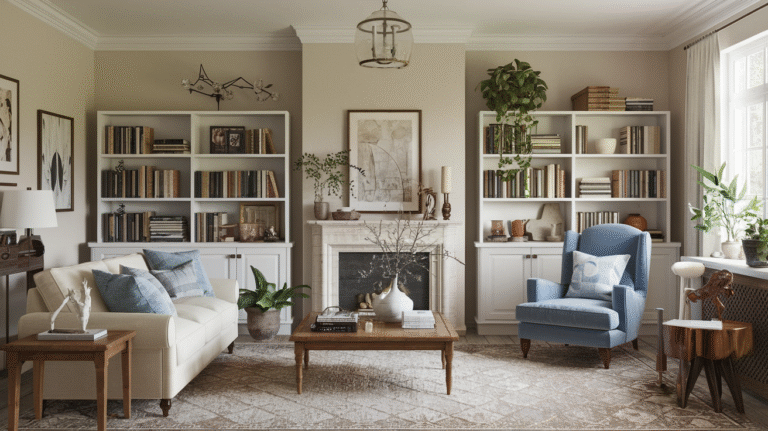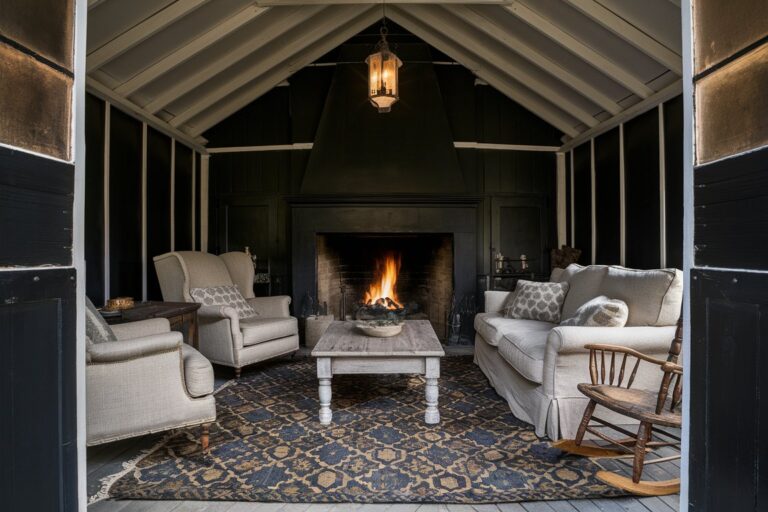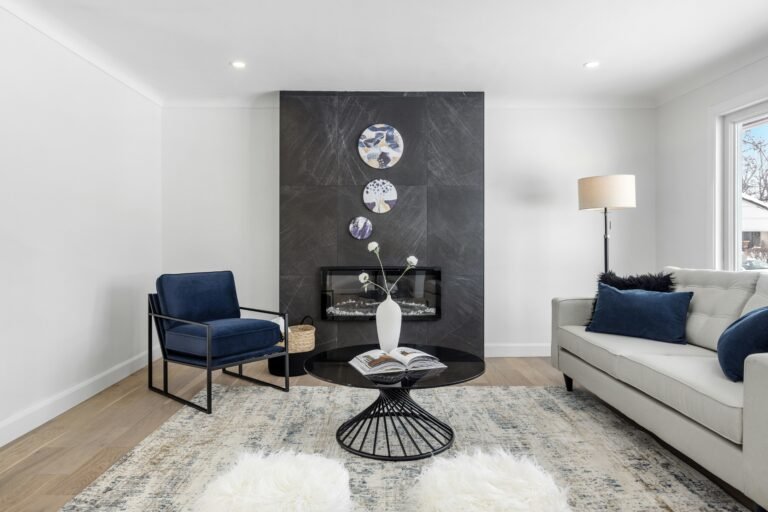The Ultimate Mid Century Living Room Style Guide for Modern Homes
This site contains affiliate links. I may earn a small commission, at no extra cost to you.
Why Everyone’s Suddenly Obsessed with Mid Century Living Room Style
You’ve probably noticed it too — those clean lines, wooden legs on everything, and warm amber tones making a comeback on your social feed. That’s Mid Century Living Room Style making waves again, and honestly, I’m not mad about it.
As someone who’s been knee-deep in home design for about four years, I’ve seen trends come and go faster than a TikTok sound — but mid-century? It’s one of those rare styles that sticks. It has this effortless mix of timeless eleganceand modern comfort that’s honestly hard to beat.

In my opinion, mid century design is like that one well-dressed friend who always looks polished without trying too hard. You know the one — linen shirt, tailored pants, maybe a retro watch — simple but stunning. That’s the energy we’re channeling for your living room.
So, what makes this design style so irresistible for modern homes? And how can you pull it off without your space looking like a Mad Men set (unless that’s your thing)? Let’s talk about it.
What Exactly Is Mid Century Living Room Style? (And Why It Still Works Today)
Let’s clear this up first — Mid Century Living Room Style isn’t just about buying anything wooden and calling it “retro.” It’s a design movement that originated between the 1940s and 1960s, celebrating functionality, simplicity, and organic beauty.
Back then, post-war America was all about optimism, new technology, and open spaces — and design followed suit. Furniture became sleek, homes got brighter, and designers ditched the fussiness of the earlier decades.

In my experience, what makes mid-century design still so relevant is its balance. It’s not overly minimalist like modern Scandinavian design, but it’s not as ornate as traditional interiors either. It hits this perfect sweet spot of being clean yet cozy, stylish yet practical.
Key Principles of Mid Century Living Room Design
Let’s get to the DNA of the style — here’s what defines it:
- Clean Lines: Straightforward silhouettes without excessive ornamentation. Think tapered legs, smooth edges, and geometric shapes.
- Natural Materials: Wood (especially walnut, teak, and oak) reigns supreme, paired with glass, leather, and metal.
- Function First: Every piece of furniture serves a purpose. If it’s not functional, it doesn’t belong.
- Organic Shapes: Curves inspired by nature—oval coffee tables, round mirrors, or shell chairs.
- Bold Colors: Earthy tones with pops of mustard yellow, burnt orange, olive green, or turquoise.
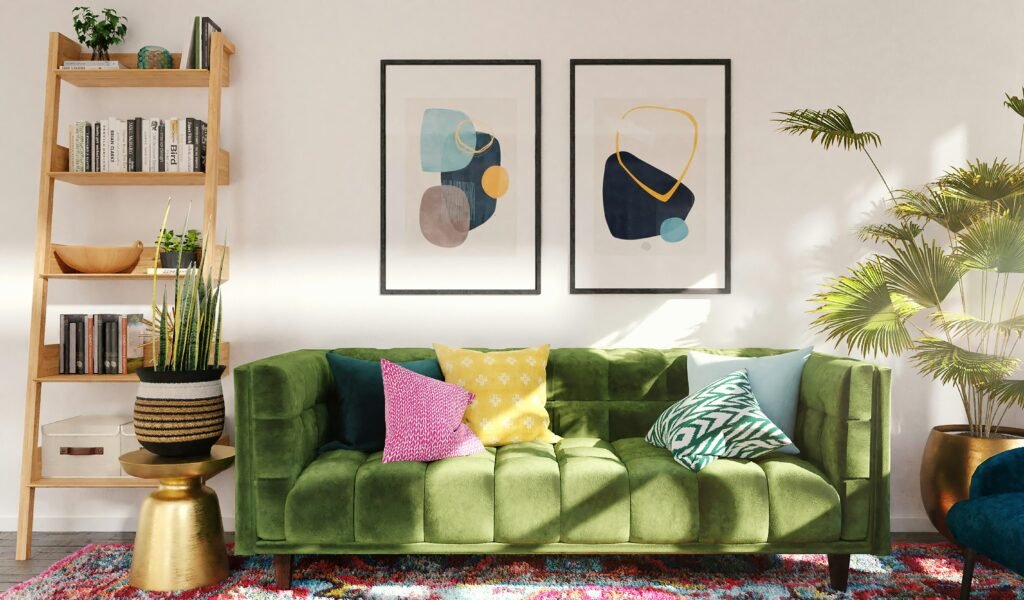
Ever wondered why it still fits so beautifully in modern homes? Because the principles behind it — functionality, openness, and warmth — are exactly what we crave in today’s spaces.
Why Mid Century Living Room Style Feels So Perfect for Modern Homes
I’ll be honest — when I first started working in interior design, I used to think “retro” styles might feel dated in today’s tech-filled homes. But I was wrong. Mid Century Living Room Style is shockingly adaptable.
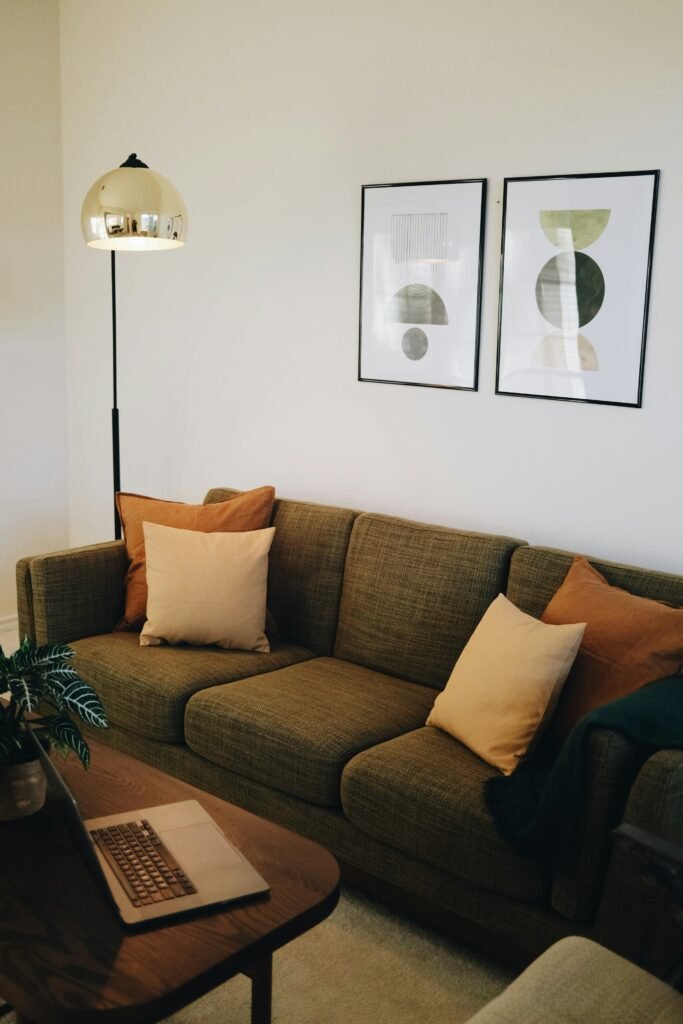
Here’s why it works so well even now:
1. It Complements Modern Architecture
If your home has open layouts, big windows, or lots of natural light — congratulations, you already have the perfect canvas. Mid-century furniture’s clean lines and low profiles keep everything feeling airy and balanced, not cluttered.
2. It’s Minimal but Not Boring
You know how some minimalist spaces feel like they belong in a furniture showroom? Not this one. Mid century interiors have soul. Warm woods, rich textures, and soft lighting make the space feel cozy while still keeping things streamlined.
3. It’s Easy to Mix with Other Styles
Here’s a little designer secret: mid-century design plays nice with almost anything.
You can blend it with boho, Scandi, or even industrial elements — it still works. For instance, I once styled a client’s space where a sleek walnut credenza sat next to a woven rattan chair and a modern metal lamp. It looked incredible — balanced yet interesting.
4. It Feels “Lived-In”
Unlike ultra-modern styles that can feel sterile, Mid Century Living Room Style welcomes imperfections — wood grains, natural textures, vintage finds. That “lived-in” warmth makes your space feel human, not like a catalog page.
How to Identify True Mid Century Furniture (Without Getting Duped)
Let’s be real — the market is flooded with “mid-century inspired” pieces right now. And while some are worth every penny, others are… let’s say, better admired from afar.
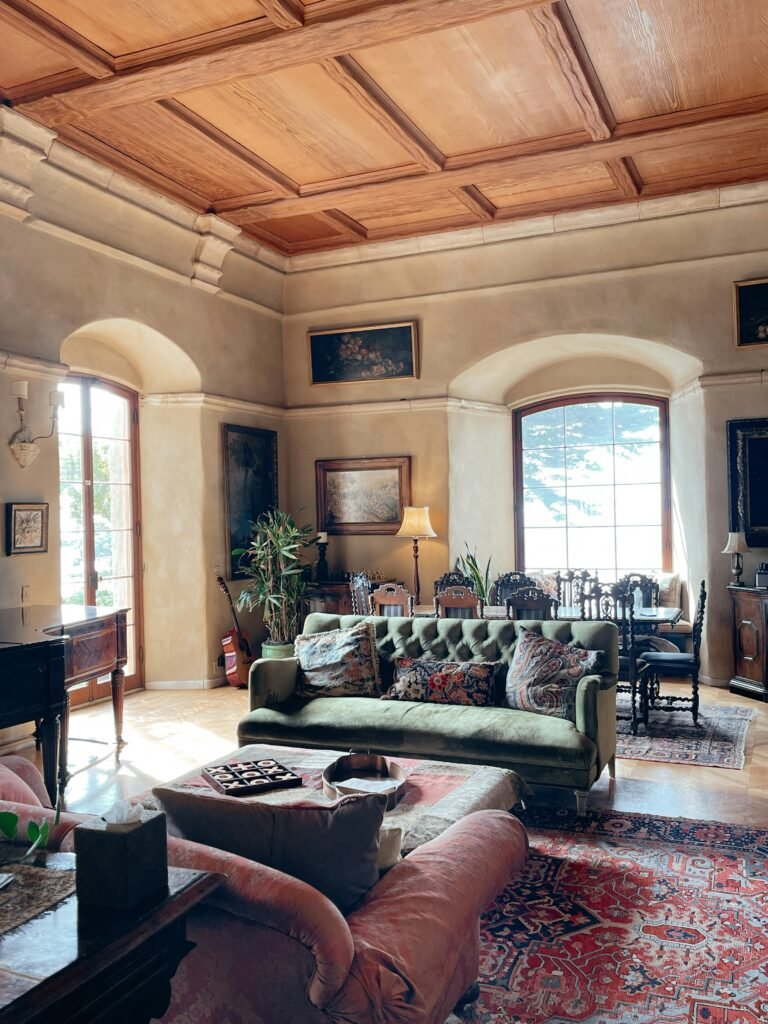
So, how do you tell the real deal from a wannabe?
1. Check the Legs
Those tapered wooden legs are iconic. In my experience, the easiest way to spot mid-century style is by the base of your furniture. Sofas, chairs, and tables usually stand on slender, angled legs — often made of solid wood.
2. Look at the Materials
Real mid-century pieces (or high-quality replicas) often use walnut or teak wood. The finish is warm, slightly matte, and never overly glossy. If it looks like it’s made of plastic or has a shiny veneer, it’s likely a cheaper imitation.
3. Keep It Simple
The golden rule: form follows function. Mid-century pieces aren’t overloaded with details. They let the materials and structure shine. If something looks overly ornate — carved arms, fancy inlays — it’s probably not true mid-century.
4. Designer Names to Know
If you’re into authenticity (and have the budget for it), look out for designs by legends like:
- Charles and Ray Eames
- Eero Saarinen
- Hans Wegner
- Arne Jacobsen
- Florence Knoll
Even if you’re buying replicas, these names are your design compass.
The Color Palette That Defines Mid Century Living Room Style
If furniture is the backbone, color is the soul. Choosing the right hues can completely transform your living room into a mid-century dream.
In my opinion, the best part about this style is how balanced the colors are — warm, earthy bases mixed with bold, playful accents.
Here’s a quick breakdown:
1. The Neutrals (Your Foundation)
Start with calm, neutral tones for your walls and big furniture pieces:
- White or Cream: Keeps the space open and bright.
- Beige or Warm Gray: Adds depth without overwhelming.
- Light Wood: Great for flooring and cabinetry.
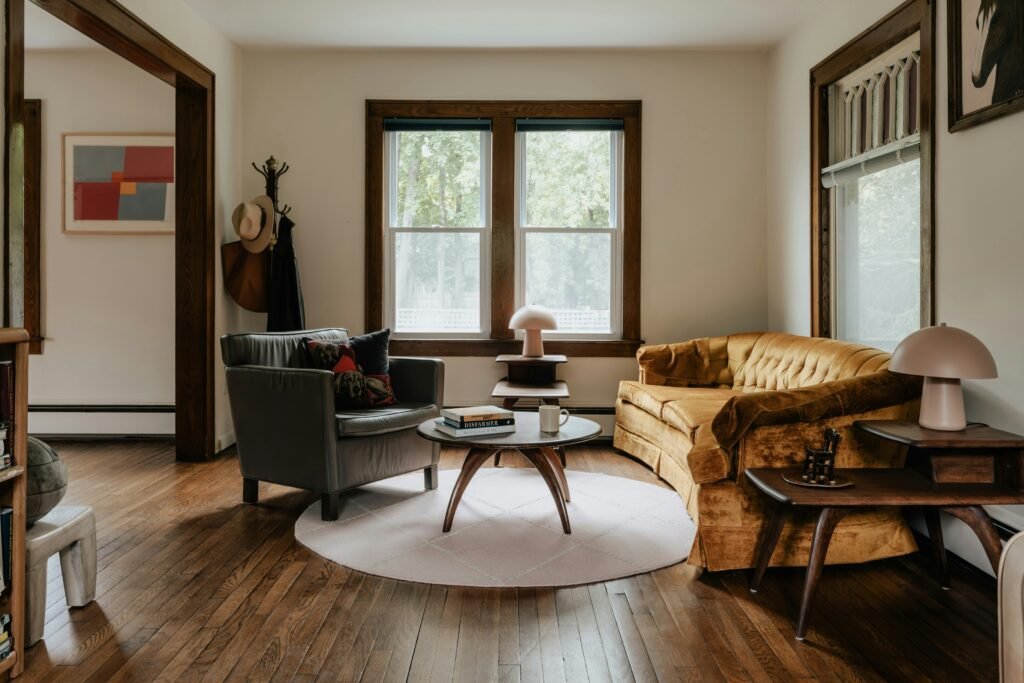
These shades form your clean canvas — the “calm before the color storm.”
2. The Earthy Warm Tones
Mid-century rooms love warmth. Think:
- Walnut Brown
- Terracotta
- Burnt Orange
- Mustard Yellow
They bring that signature 1950s glow — cozy, nostalgic, but still modern.
3. The Pop Colors (Used Sparingly)
Accent colors make your room pop without feeling chaotic. Use them in cushions, art, or decor pieces:
- Olive Green
- Turquoise Blue
- Deep Teal
- Brick Red
Whenever I design a mid-century inspired space, I like to add one bold hue in moderation — maybe a turquoise vase or an emerald armchair — and balance it with plenty of neutrals.
4. Metals and Woods
Warm metals like brass or bronze work beautifully with walnut furniture. Avoid overly shiny chrome unless you’re aiming for a more modern twist.
Lighting: The Secret Weapon of a Mid Century Living Room
If you only take one tip from me — let it be this: lighting can make or break your mid century vibe.
The right lighting transforms everything — it highlights textures, warms up wooden tones, and creates that soft evening glow mid-century interiors are famous for.
1. Floor Lamps with Personality
Iconic tripod lamps, arc floor lamps, or sculptural bases are all great choices. I personally love lamps with brass finishesand fabric drum shades — they give off that “vintage yet sophisticated” energy.

2. Pendant Lights and Sconces
Go for geometric shapes or frosted glass globes. Those globe pendant lights are basically the jewelry of a mid-century space — elegant but never loud.
3. Layered Lighting
Don’t rely on one overhead light. Combine floor lamps, table lamps, and wall sconces for a cozy, ambient feel. Trust me, it changes the entire mood.
4. Pro Tip: Warm Bulbs Only
Cool white bulbs kill the vibe instantly. Go for warm, soft lighting (2700K–3000K) to keep everything glowing and inviting.
How to Design the Perfect Mid Century Living Room Layout
Let’s be honest — even the most beautiful furniture can fall flat if your layout doesn’t make sense. In my experience, Mid Century Living Room Style thrives on balance, openness, and conversation. You want your room to feel inviting, not like a museum where people are afraid to sit down.
So, how do you nail that “retro yet livable” setup? Let’s walk through it.
1. Start with a Focal Point
Every living room needs a star — that one element that grabs attention. It could be:
- A vintage wooden credenza under your TV
- A statement sofa with clean lines and tapered legs
- Or even a brick fireplace surrounded by mid-century art
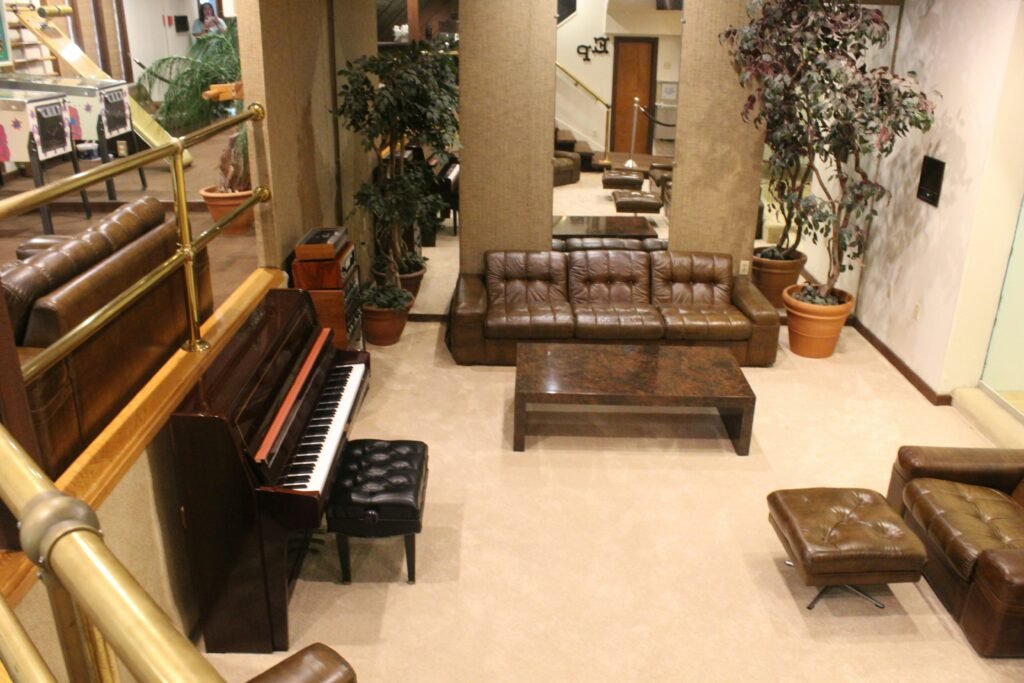
In my opinion, once you pick your focal point, everything else should quietly complement it. Don’t crowd it. Give it space to breathe — that’s where mid-century magic happens.
2. Float Your Furniture (Yes, Away from the Walls)
Here’s one thing I always recommend to clients: don’t push your furniture against the walls.
Mid-century rooms thrive on air flow and open conversation zones. Try floating your sofa in the middle of the room, maybe paired with two armchairs facing it. Add a coffee table between them, and voilà — instant cozy, intentional layout.
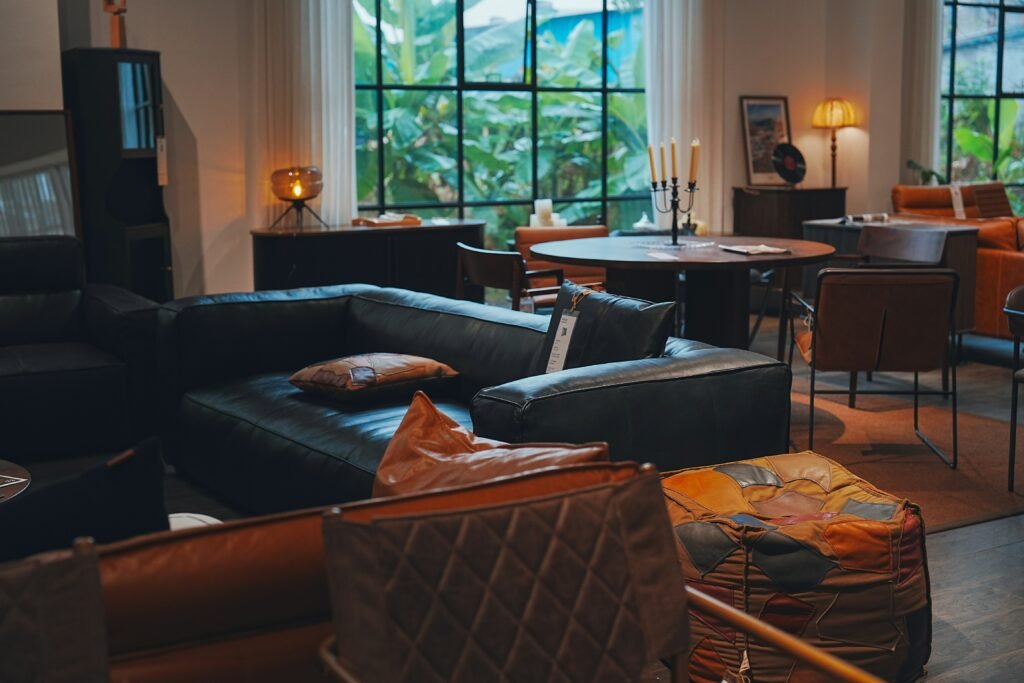
Ever noticed how the best mid-century rooms look “social”? That’s the secret — furniture placement encourages connection.
3. Keep Pathways Clear
A cluttered layout kills the aesthetic. Make sure there’s at least 3 feet of walking space around major pieces. It keeps the room functional, especially if you entertain often.
4. Think Symmetry (But Not Too Perfect)
Mid-century design loves balance, but not rigid symmetry.
I like to pair a bold armchair on one side of the room with a floor lamp on the other — same height, different shape. It feels intentional without being stiff.
Mixing Mid Century and Modern: The Art of the “Updated Retro” Look
Now, this is where most people mess up — they go all-in on mid-century furniture and end up feeling like they’re living in a 1960s time capsule. Don’t do that to yourself.

In my experience, the trick is to blend mid-century classics with modern touches. The result? A space that feels timeless, not themed.
1. Choose Statement Mid Century Pieces, Then Layer In Modern Comfort
Start with one or two standout mid-century items — maybe a walnut sideboard or a Saarinen-inspired chair. Then bring in modern comfort pieces like a plush sectional, textured rugs, or abstract art to soften the retro vibe.
It’s all about contrast — clean mid-century lines paired with modern textures create visual depth.
2. Mix Old and New Materials
Mid-century furniture often uses solid wood and metal. You can modernize that by adding glass, stone, or soft bouclé fabrics. I once styled a space with a vintage walnut coffee table and a modern cream boucle sofa — the combination was flawless.
3. Add a Dash of Modern Lighting
Modern floor lamps with minimal bases or sculptural forms blend beautifully with retro spaces. Avoid overly industrial fixtures; instead, choose brass, matte black, or frosted glass finishes that nod to the past but still feel fresh.
4. Use Contemporary Art or Decor
Swap out vintage posters for modern abstract art or sculptural ceramics. It creates a dynamic dialogue between eras — classic foundation, modern expression.
5. Keep Technology Subtle
We all love our flat-screen TVs, but nothing screams “modern intrusion” like a black rectangle dominating your retro setup.
In my opinion, hide your tech cleverly — mount it above a vintage console or add floating shelves around it to make it feel integrated.
Affordable Ways to Achieve Mid Century Living Room Style
Here’s some good news: you don’t need a designer’s budget to create a magazine-worthy Mid Century Living Room Style. Trust me — I’ve worked with clients on tight budgets who pulled off this look beautifully.
1. Shop Smart (and Vintage)
Thrift stores, estate sales, and even Facebook Marketplace are gold mines. Look for furniture with:
- Wooden frames
- Tapered legs
- Neutral upholstery
A little wear adds character — it’s part of the mid-century charm. I once scored an authentic walnut coffee table for less than a dinner out. With a quick polish, it looked showroom-ready.
2. Use Replicas Wisely
There’s no shame in replicas if they’re well-made. Just avoid plastic or shiny finishes. Go for solid wood, neutral tones, and matte textures that mimic the real thing.
3. DIY Your Decor
Mid-century art is known for geometric patterns and bold colors. If you’re feeling creative, paint your own abstract canvas or repurpose vintage prints. You’d be surprised how a DIY piece can tie the whole room together.
4. Swap Out Hardware
Replacing drawer pulls or cabinet knobs with brass or walnut handles is a tiny upgrade that makes a huge difference. Seriously, small details like that elevate the whole space.
5. Layer Textures, Not Just Furniture
Mid-century spaces thrive on tactile balance — soft rugs, linen curtains, leather cushions. Even if your furniture is simple, the textures create depth and coziness.
Decor Elements That Bring the Mid Century Living Room Style to Life
Alright, you’ve got the furniture, the colors, and the layout. Now comes the fun part — styling. In my opinion, this is where your personality really shines through.
1. Rugs with Retro Personality
A good rug grounds your space and sets the tone. Go for:
- Geometric patterns
- Muted warm tones
- Low pile textures
Bonus tip: Make sure your rug is large enough that at least the front legs of your sofa and chairs sit on it. That’s a mid-century design rule I swear by.
2. Wall Art That Speaks Volumes
Think bold shapes, simple lines, or abstract forms. I often recommend oversized art pieces rather than clusters — it keeps the visual focus strong and uncluttered.
3. Add Greenery
Mid-century interiors love a touch of life. Go for statement plants like:
- Fiddle Leaf Fig
- Snake Plant
- Rubber Tree
Their sculptural leaves complement the clean lines of the furniture beautifully. Plus, they add color without overwhelming your palette.
4. Minimalist Accessories
When it comes to decor, less is more. A few well-chosen objects — a ceramic vase, a stack of coffee table books, or a sculptural lamp — can say more than a dozen random knick-knacks.
5. Use Mirrors Wisely
Mirrors reflect light and make rooms feel larger. I recommend round or oval mirrors with wooden or brass frames for that authentic mid-century touch.
The Perfect Fabrics and Textures for Mid Century Living Rooms
In my opinion, texture is what separates a “nice” room from a “wow” room. Mid-century interiors nail this through tactile diversity — smooth woods, rough textiles, and soft upholstery all playing together.
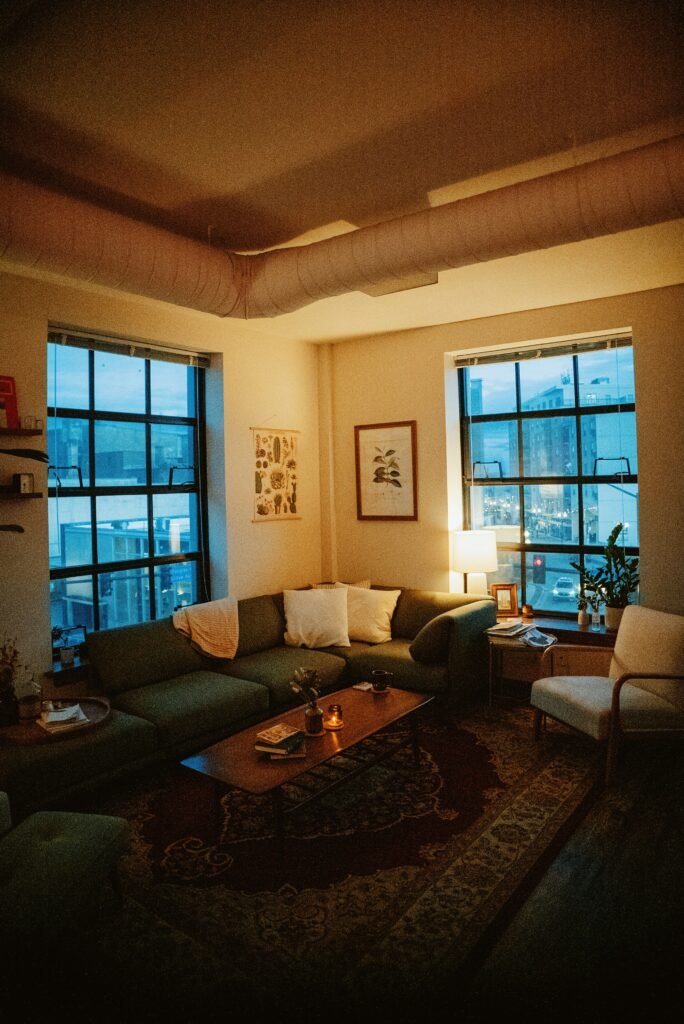
Here’s what works best:
1. Upholstery
- Leather: For a timeless, rich feel.
- Linen or Cotton: For casual warmth.
- Velvet: For a touch of retro luxury.
I personally love using leather sofas paired with linen throw pillows — that contrast feels so lived-in yet elegant.
2. Rugs
Stick with flatweave or low-pile wool rugs in earthy colors or bold geometric prints. They complement wooden floors perfectly.
3. Curtains
Skip heavy drapes. Go for sheer or linen panels that allow light to filter through — natural light is your best mid-century accessory.
4. Accent Textures
- Rattan baskets
- Ceramic vases
- Woven cushions
These small touches add layers of visual interest without breaking the clean aesthetic.
Pro Tips from Experience (That Pinterest Won’t Tell You)
After working on a dozen mid-century inspired spaces, I’ve gathered a few lessons the hard way — the kind of stuff you won’t always find in a design magazine.
1. Balance Is Everything
Too much wood? It’ll feel heavy. Too many colors? It’ll feel chaotic.
The trick is to balance tones and textures — if you have a walnut coffee table, try adding a cream sofa or a light rug to keep the space airy.
2. Don’t Overmatch
I’ve seen people buy “mid-century furniture sets” that look identical. Please, don’t. Mix different tones and shapes instead. Variety makes it feel authentic.
3. Vintage Doesn’t Mean Old-Fashioned
Just because a piece is from the 1960s doesn’t mean your space has to feel like it. Pair old with new, and the room instantly feels curated rather than outdated.
4. Focus on Feel, Not Perfection
Mid-century style is about ease. It should feel natural and lived-in — not like you’re constantly fluffing pillows or adjusting decor.
Common Mid Century Living Room Mistakes (And How to Fix Them Fast)
Alright, time for some real talk. As much as I adore Mid Century Living Room Style, I’ve seen it go wrong — reallywrong. Sometimes people mean well, but a few missteps can turn a stylish vision into something that looks straight out of grandma’s basement (minus the charm).
Here are the most common mistakes I’ve noticed — and how to avoid them.
1. Overdoing the “Retro” Vibe
In my opinion, this is the number one trap. People hear “mid-century” and immediately fill the room with every teak and orange item they can find. Suddenly, it’s not retro-cool anymore; it’s a time machine to 1965.
My fix: Keep one or two vintage statement pieces — like a walnut credenza or an Eames-style chair — and balance them with modern decor. For instance, add a minimalist lamp, an abstract painting, or a soft contemporary rug.
2. Ignoring Comfort for the Sake of Style
I get it — that angular wooden chair looks gorgeous on Pinterest. But if it feels like sitting on a plank, what’s the point?
According to my experience, your Mid Century Living Room Style should be as comfortable as it is beautiful. Choose pieces with clean lines and cushioned seats. You want furniture you can actually relax in, not just admire from afar.
3. Too Many Competing Woods
Wood is the heart of mid-century design — but mixing too many shades can create chaos. I’ve walked into rooms where walnut, oak, cherry, and mahogany were all fighting for attention. It’s… a lot.
My recommendation: Stick to two wood tones max. Walnut is always a safe, warm choice, and you can complement it with lighter or darker accents. Consistency creates harmony.
4. Forgetting About Scale
Mid-century furniture tends to be low-profile and sleek. If you pair that with bulky modern pieces, the proportions get weird fast.
In my opinion, you should keep proportions consistent. For example, pair a low sofa with an equally low coffee table — that’s what keeps the flow cohesive.
5. Not Paying Attention to Lighting
You’d be surprised how many beautifully styled rooms fall flat because of bad lighting. A harsh white bulb instantly kills the cozy mid-century mood.
My fix: Use warm lighting (around 2700K), and include multiple sources — a floor lamp, a wall sconce, and maybe a small table lamp. It’s the secret to getting that golden-hour glow indoors.
Personalizing Your Mid Century Living Room Style (So It Feels Like You)
Let’s face it — no one wants a living room that feels like a carbon copy of a Pinterest board. Your home should tell yourstory. The beauty of Mid Century Living Room Style is that it’s flexible enough to let your personality shine.

Here’s how to make it uniquely yours.
1. Add a Modern Twist
Want to make your mid-century space feel fresh? Mix in something unexpected. Maybe it’s a contemporary art print, a neon accent lamp, or a chunky modern coffee table.
When I style spaces for clients, I love pairing sleek walnut furniture with a bold modern rug — it adds just the right touch of surprise.
2. Showcase Personal Art or Memories
Who says mid-century walls need to be all abstract art and geometric shapes? Frame your favorite travel photos in simple wooden or brass frames. That’s how you blend personal memories with timeless style.
3. Use Statement Lighting as Decor
Lighting doesn’t just illuminate a room — it defines it. In my opinion, a sculptural pendant light or a brass arc floor lamp can completely transform your space. Choose something that sparks joy every time you look at it.
4. Layer Meaningful Textures
If you’re into tactile comfort (and who isn’t?), combine different fabrics — linen throws, velvet cushions, leather chairs, woven rugs. It’s a sensory experience, not just a visual one.
5. Mix Vintage Finds with New Favorites
In my experience, nothing feels more authentic than mixing eras. A mid-century wooden sideboard paired with a modern ceramic vase or a sleek coffee table book feels balanced and real — not staged.
The Emotional Impact: Why Mid Century Design Just Feels “Right”
Now, here’s something I rarely see people talk about — the feeling this style evokes.
Mid Century Living Room Style doesn’t just look good; it feels good. There’s something deeply grounding about the warm wood tones, balanced forms, and nostalgic charm. It’s cozy but refined. Modern but timeless.
Every time I walk into a mid-century styled room, I feel this quiet calm — like everything’s in harmony. It’s not about perfection; it’s about ease.
Maybe that’s why, even after 70 years, people still gravitate toward it. It’s not just a trend — it’s a philosophy of living simply, beautifully, and with intention.
A Few Insider Secrets from My Experience
Since we’re practically friends now, let me share a few extra tidbits I’ve learned from styling mid-century spaces over the years.
1. The 60-30-10 Color Rule Works Wonders
Use 60% neutrals, 30% mid-tones, and 10% bold accents. For instance, cream walls (60%), walnut furniture (30%), and mustard cushions (10%). That formula keeps everything balanced and visually satisfying.
2. Don’t Underestimate Negative Space
One of the biggest design mistakes I see is overfilling rooms. Remember — empty space has value. In mid-century design, what you leave out matters as much as what you include.
3. Authenticity Over Perfection
I always tell clients: perfection is boring. A slightly scratched sideboard or a vintage lamp with patina adds character. The small imperfections make it real — and real feels good.
Styling Tips for the Finishing Touches
You’ve got the big picture sorted, now let’s fine-tune the details that make your living room feel truly curated.

1. Add a Pop of Brass or Gold
Nothing complements mid-century tones like a little metallic warmth. Try a brass tray, gold-rimmed mirror, or metallic base lamp. It’s just enough sparkle without being flashy.
2. Don’t Forget Texture on Walls
Wood paneling, fabric wall hangings, or even 3D artwork can add dimension. If you’re renting, try peel-and-stick wood panels — easy to install, easy to remove.
3. Mix Shapes
If everything in your room is rectangular, throw in a round coffee table or oval mirror to break up the monotony. Mid-century design loves geometry — play with it.
4. Embrace Symmetry with a Twist
Pair matching lamps or side tables for that classic balanced look, but offset them slightly with asymmetrical decor — maybe one side gets a plant, the other a stack of books.
5. Keep It Fresh
Don’t let your living room stagnate. Swap out cushions seasonally, move artwork around, or bring in new plants. Small updates keep your space feeling alive.
Final Thoughts: Your Mid Century Living Room, Your Way
So, here’s the takeaway — Mid Century Living Room Style isn’t about sticking to strict rules or chasing perfection. It’s about creating a space that feels effortlessly stylish, inviting, and uniquely yours.
In my opinion, this design philosophy is what makes it so timeless. The blend of warm woods, clean lines, and organic shapes brings a kind of calm sophistication that never goes out of style.
Whether you go all-in with vintage furniture or just sprinkle in a few mid-century accents, remember — design should serve you. Your living room should feel like a reflection of your taste, your habits, and your stories.
And hey, if your friends walk in and say, “Wow, this feels straight out of an architectural magazine,” you’ll know you nailed it.
Because when done right, Mid Century Living Room Style isn’t just decor — it’s a lifestyle. A celebration of simplicity, elegance, and warmth that fits right into our modern world.
Now, your turn:
Take a look at your living room and ask yourself — what’s one small change you can make today to bring in that timeless mid-century charm?
Maybe it’s swapping out your lamp, adding a warm-toned rug, or finally floating your sofa away from the wall.
Whatever it is, start small — and watch your space transform.

